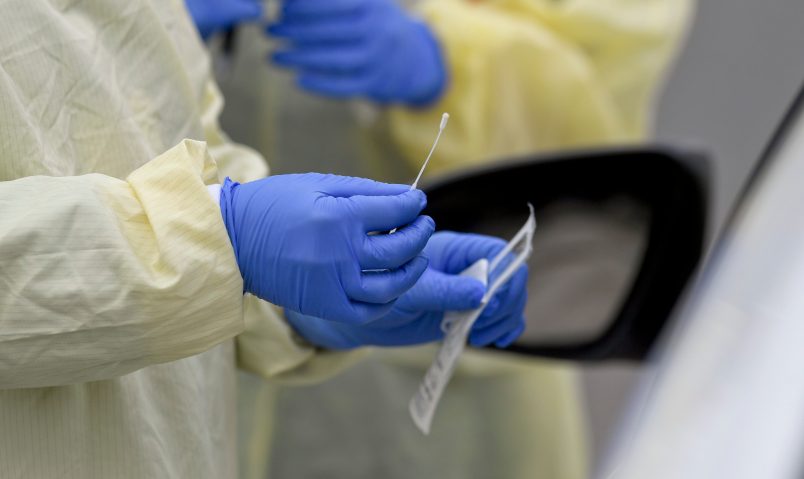In much of the country, even those with COVID-19 symptoms are struggling to get tested for the virus. But in New Mexico, an extremely rural and low income state, the governor announced last week that certain residents without symptoms can now get tested.
New Mexico’s expansion of its testing eligibility — which now allows testing for asymptomatic people who are exposed to COVID-19 or who live in group living facilities like nursing homes — is a testament to how quickly the state was able to scale up its testing.
Until last week, only New York, Washington and Louisiana were turning around more tests on a per capita basis than New Mexico, according to an analysis by the Kaiser Family Foundation. A few other states have since caught up, but New Mexico has remained in the top 10 — a remarkable achievement for a state where four-in-10 residents live under 200 percent of the federal poverty line.
A spokesperson for Gov. Michelle Lujan Grisham (D) told TPM that the decision to expand testing eligibility was driven in part by “growing body of evidence showing benefits of testing asymptomatic people and keeping those confirmed positive patients home”
The federal government’s slowness to expand testing was a crucial stumbling block in the U.S.’s failure to contain the coronavirus. New Mexico is hoping its aggressive testing could protect its strained health care system, which, according to Rep. Xochitl Torres Small (D-NM) is “already on the brink.”
“It’s exceptionally vital that New Mexico acts and takes these proactive actions to get testing, because we don’t have the hospital bed capacity or ventilators to address an enormous surge,” Torres Small, whose far-flung district covers the southern half of the state, told TPM Tuesday.
She and others involved in the testing ramp-up effort described a coordinated campaign between the governor’s office, health officials and the state’s congressional delegation. Officials moved quickly, setting up drive-through testing sites just three days after first positive case was confirmed. Laboratories in New Mexico have developed a diverse set of testing tools with the aims of both meeting demand and being prepared if individual manufacturers see shortages in their supplies.
On March 23, Governor Lujan Grisham ordered that each of New Mexico’s 33 counties have at least one testing site. The state’s Department of Health website now lists 51 different locations.
“We were aggressive about diversifying early, getting as much supply and making it easy for people to go and get tested, including drive-through testing, at a time when that was not necessarily considered the right approach by some folks,” Sen. Martin Heinrich (D-NM) said on a press call last week.
Part of New Mexico’s success stems from how quickly its laboratories were able to build out their processing abilities so that they can now turn around several hundred tests at a time. The state-run laboratory and a private Albuquerque-based laboratory called TriCore Reference Laboratories have been two of the state’s biggest test processing sites.
TriCore began processing the CDC-style of coronavirus tests on March 12, the day after New Mexico’s first presumptive case, and by the end of the month was expanding its capabilities to process three other types of tests. The lab can now process 1,000 tests a day and has no significant backlog.
As of Tuesday, more than 22,000 tests had been processed by the five labs doing testing in the state.
Heinrich and Lujan Grisham were on the phone daily coordinating outreach to pharmaceutical companies and manufacturers, Heinrich said on the call last week, as the state decided early on not just to rely on the federal government to deliver testing supplies.
But the federal government still got in New Mexico’s way by reportedly interfering in its attempts to purchase more materials for the TriCore laboratory, according to the governor’s office, prompting Lujan Grisham to voice her frustrations on a mid-March call with President Trump. She secured a follow-up call with Vice President Mike Pence, who assured her the federal government would get New Mexico what it needed, the Santa Fe New Mexican reported.
Beyond the actions that the governor took after the outbreak, officials also credit the existing relationships and infrastructure political leaders had built with the state’s medical system, where making sure remote New Mexican communities have access to care has been a long-standing priority.
A third of the state is on Medicaid, which was expanded under the Affordable Care Act in 2013. Another 15 percent of New Mexicans are on Medicare.
The systems in place due to Project ECHO — a telemedicine and community learning initiative launched by the University of New Mexico in 2003 — also facilitated coordination around coronavirus response, according to people involved in the effort.
Rep. Torres Small told TPM her focus in the testing efforts was making sure the hospitals in her district were getting the testing tools and laboratory support they needed as the state ramped up testing.
Her office began reaching out to hospitals on March 12, the day after the first travel-related COVID-19 case was reported in the state. The first cases of community spread within New Mexico were announced the following week.
“The first part of that was really listening and going through all of our contacts with the rural hospitals and other hospitals in the district and asking them what their big challenges were. Testing came up to the top right away,” she said.



